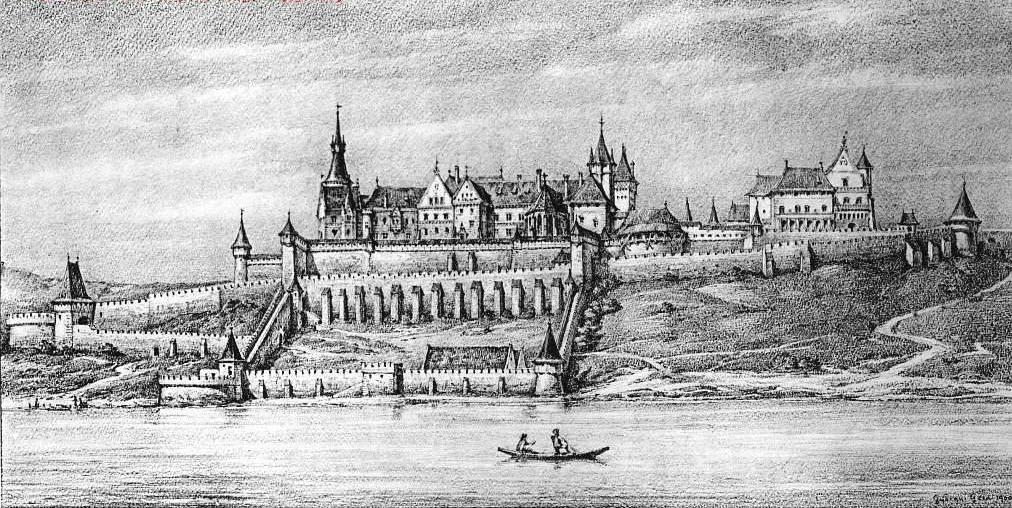 |
Hungarian National Gallery
The Hungarian National Gallery (also known as Magyar Nemzeti Galéria), was established in 1957 as the national art museum. It is located in Buda Castle in Budapest, Hungary. Its collections cover Hungarian art in all genres, including the works of many nineteenth- and twentieth-century Hungarian artists who worked in Paris and other locations in the West. The primary museum for international art in Budapest is the Museum of Fine Arts. Exhibitions The National Gallery houses Medieval, Renaissance, Gothic art, and Baroque Hungarian art. The collection includes wood altars from the 15th century. The museum displays a number of works from Hungarian sculptors such as Károly Alexy, Maurice Ascalon, Miklós Borsos, Gyula Donáth, János Fadrusz, Béni Ferenczy, István Ferenczy and Miklós Izsó. It also exhibits paintings and photographs by major Hungarian artists such as Brassai and Ervin Marton, part of the circle who worked in Paris before World War II. The gallery display ... [...More Info...] [...Related Items...] OR: [Wikipedia] [Google] [Baidu] |
 |
Buda Castle
Buda Castle ( hu, Budavári Palota, german: link=no, Burgpalast) is the historical castle and palace complex of the King of Hungary, Hungarian Kings in Budapest. It was first completed in 1265, although the massive Baroque architecture, Baroque palace today occupying most of the site was built between 1749 and 1769. The complex in the past was referred to as either the Royal Palace ( hu, Királyi-palota) or the Royal Castle ( hu, Királyi Vár, german: link=no, Königliche Burg). The castle now houses the Hungarian National Gallery and the Hungarian National Museum. Buda Castle sits on the southern tip of Castle Hill (Buda), Castle Hill, surrounded by the touristic area known as Várnegyed, Várnegyed (Castle Quarter), which is famous for its Medieval architecture, Medieval, Baroque architecture, Baroque, and Neoclassical architecture, Neoclassical houses, churches, public buildings, and monuments. The hill is linked to :hu:Clark Ádám tér, Clark Ádám Square and the Széchen ... [...More Info...] [...Related Items...] OR: [Wikipedia] [Google] [Baidu] |
|
János Fadrusz
János Fadrusz (2 September 1858, Pressburg – 26 October 1903, Budapest) was a Hungarian sculptor in the Neoclassical style. He was especially noted for his works on historical subjects. Biography He was the son of a poor cheesemaker, who had emigrated from Moravia in the 1850s and married Therese Ewinger, a winemaker's daughter. They later ran a small grocery store. He showed a talent for drawing at an early age. After completing his military service in Prague, he worked as a woodcarver and porcelain painter, although he turned down a job offer at the Herend Porcelain Manufactory. Later, he also learned locksmithing, but his artistic inclinations eventually asserted themselves. In 1883, he drew attention to himself at a local art exhibit by creating a plaster bust of Ahasuerus, and he was able to obtain a special scholarship from the Minister of Education, Ágoston Trefort. He left Pressburg in 1886, heading for Vienna to take lessons from the sculptor, Viktor Tilgner. Afte ... [...More Info...] [...Related Items...] OR: [Wikipedia] [Google] [Baidu] |
|
 |
Bertalan Székely
Bertalan Székely (8 May 1835, Kolozsvár, Transylvania, Kingdom of Hungary (Now Cluj-Napoca after annexation by Romania following the Treaty of Trianon – 21 August 1910, Budapest) was a Hungarian history and portrait painter who worked in the Romantic and Academic styles. Biography Born into a family that was originally part of the Transylvanian nobility, his father was a court clerk. Although his family wanted him to become an engineer, he studied at the Academy of Fine Arts, Vienna from 1851 to 1855, under Johann Nepomuk Geiger and Carl Rahl.Brief biography @ the Magyar Életrajzi Lexikon. He then returned to his hometown where, for the next three years, he worked as an art teacher. After a year of employment with Count Aichelburg in [...More Info...] [...Related Items...] OR: [Wikipedia] [Google] [Baidu] |
 |
Miklós Barabás
Miklós Barabás (10 February 1810, in Markersdorf, Covasna County, Romania – 12 February 1898, in Budapest) was a Hungarian painter. He is mostly known for his portrait paintings, including a famous portrait of a young Franz Liszt, done in 1847 and an 1853 portrait of Emperor Franz Joseph I. Biography Miklos Barabás was educated at the Protestant school of Nagyenyed. He painted from an early age, and in 1829 he was a pupil of Johann Ender in Vienna for a while. Back in Kolozsvár in 1830 he learned lithography from Gábor Barra (1799-1837). In 1834-1835 he traveled to Italy, where he learned watercolor painting from the Scottsman William Leighton Leitch who was six years his senior; they became friends and toured and painted in the Lago Maggiore region in 1834, and Leitch was a great influence on Barabás's future work. He finally settled in Pest in 1855. He won the great support of the literary and political leaders of the Reform Age, and was undeniably a pioneer of H ... [...More Info...] [...Related Items...] OR: [Wikipedia] [Google] [Baidu] |
|
József Borsos
Jozsef Borsos (21 December 1821, in Veszprém – 19 August 1883, in Budapest) was a Hungarian portrait painter and photographer; best known for his genre paintings in the Biedermeier style. Life and work His father, was a lawyer, editor and publisher. From 1837, he was a student of the religious artist, , in Budapest. He transferred to the Academy of Fine Arts, Vienna in 1840, where he studied with Leopold Kupelwieser Leopold Kupelwieser (17 October 1796, Markt Piesting – 17 November 1862, Vienna) was an Austrian painter, often associated with the Nazarene movement. Life He was the son of Johann Baptist Georg Kilian Kupelwieser (1760–1813), co-owner of a .... In 1843, he changed schools again, attending a private academy operated by Ferdinand Georg Waldmüller. He initially chose to live in Vienna, with a large clientele from the Austrian aristocracy. Financially successful, he lost most of his money speculating in the stock market, and returned to Budapest in 1861. ... [...More Info...] [...Related Items...] OR: [Wikipedia] [Google] [Baidu] |